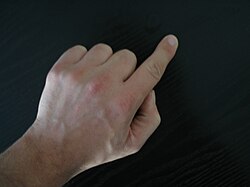Index finger
This article needs additional citations for verification. (April 2013) |
| Index finger | |
|---|---|
 | |
| Details | |
| Artery | Radial artery of index finger, proper palmar digital arteries, dorsal digital arteries |
| Vein | Palmar digital veins, dorsal digital veins |
| Nerve | Dorsal digital nerves of radial nerve, proper palmar digital nerves of median nerve |
| Identifiers | |
| Latin | Digitus II manus, digitus secundus manus, index |
| TA98 | A01.1.00.054 |
| TA2 | 152 |
| FMA | 24946 |
| Anatomical terminology | |

The index finger, (also referred to as forefinger, pointer finger, trigger finger, digitus secundus, digitus II, and many other terms), is the first finger and the second digit of a human hand. It is located between the first and third digits, between the thumb and the middle finger. It is usually the most dextrous and sensitive finger of the hand, though not the longest – it is shorter than the middle finger, and may be shorter or longer than the ring finger – see digit ratio.
"Index finger" literally means "pointing finger", from the same Latin source as indicate; its anatomical names are "index finger" and "second digit".
Uses
A lone index finger held vertically is often used to represent the number 1 (but finger counting differs across cultures), or when held up or moved side to side (finger-wagging), it can be an admonitory gesture. With the hand held palm out and the thumb and middle fingers touching, it represents the letter d in the American Sign Language alphabet. In sports, it can also represent victory, as some championship-winning teams raise their index finger (often saying "We're number one!") while posing for a championship team photo – oversized foam hands with a single upraised index are also used for this purpose; compare with the victory sign. Most humans find the index finger particularly useful for "picking" their nose. This is done when the index finger is thrust upward into the nasal passage. For the vast majority of computer users, it is the finger most often used to (left) click a mouse, as well as the finger used in the untrained 'hunt and peck' typing style.
Pointing
Pointing with index finger may be used to indicate an item or person.[1]
Around the age of one year, babies begin pointing to communicate relatively complex thoughts, including interest, desire, information, and more. Pointing in human babies can demonstrate the theory of mind, or ability to understand what other people are thinking. This gesture may form one basis for the development of human language. Non-human primates, lacking the ability to formulate ideas about what others are thinking, use pointing in much less complex ways.[2] However, dogs[3][3] and elephants[4] do understand finger pointing.
Gestures in art
As an artistic convention, the index finger pointing at the viewer is in the form of a command or summons. Two famous examples of this are recruiting posters used during World War I by the United Kingdom and the United States.
 |
 |
The index finger pointing up is a sign of teaching authority. This is shown in the depiction of Plato in the School of Athens by Raphael.[5]
 |
 |
See also
References
- ^ Gary Imai. "Gestures: Body Language and Nonverbal Communication" (PDF). Archived from the original (PDF) on March 31, 2010. Retrieved 12 November 2009.
{{cite web}}: Unknown parameter|deadurl=ignored (|url-status=suggested) (help) - ^ Day, Nicholas (26 March 2013). "Research on babies and pointing reveals the action's importance". Slate. Retrieved 25 April 2013.
- ^ a b Kirchhofer, Katharina C.; Zimmermann, Felizitas; Kaminski, Juliane; Tomasello, Michael (2012). "Dogs (Canis familiaris), but Not Chimpanzees (Pan troglodytes), Understand Imperative Pointing". PLoS ONE. 7 (2): e30913. Bibcode:2012PLoSO...730913K. doi:10.1371/journal.pone.0030913. PMC 3275610. PMID 22347411.
{{cite journal}}: Unknown parameter|laydate=ignored (help); Unknown parameter|laysource=ignored (help); Unknown parameter|laysummary=ignored (help)CS1 maint: unflagged free DOI (link) - ^ Goodman, M.; Sterner, K. N.; Islam, M.; Uddin, M.; Sherwood, C. C.; Hof, P. R.; Hou, Z. C.; Lipovich, L.; Jia, H.; Grossman, L. I.; Wildman, D. E. (2009). "Phylogenomic analyses reveal convergent patterns of adaptive evolution in elephant and human ancestries". Proceedings of the National Academy of Sciences. 106 (49): 20824–9. Bibcode:2009PNAS..10620824G. doi:10.1073/pnas.0911239106. JSTOR 40536081. PMC 2791620. PMID 19926857.
{{cite journal}}: Unknown parameter|laydate=ignored (help); Unknown parameter|laysource=ignored (help); Unknown parameter|laysummary=ignored (help) - ^ Brusati, Celeste; Enenkel, Karl A. E.; Melion, Walter (Nov 11, 2011). The Authority of the Word: Reflecting on Image and Text in Northern Europe, 1400-1700. Brill. p. 168. ISBN 9004215158.
External links
![]() Media related to Index finger at Wikimedia Commons
Media related to Index finger at Wikimedia Commons
